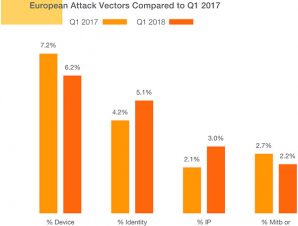Europe continues to be a cybercrime hub
Product Information
ThreatMetrix announced new data revealing a 30 percent year-on-year increase in the volume of cyberattacks hitting Europe in the first quarter of 2018.

As attacks patterns morph across the region, European digital businesses were hit with 80 million fraud attempts, as they experienced more pronounced spikes of peak attack periods throughout Q1 2018 compared to previous years. There has been an evolution from short, isolated peaks of fraud attacks to more sustained, high-volume attacks across a number of days or even weeks. As a result, the onus is upon European digital businesses to invest in innovative, real-time security capabilities that are robust enough to withstand these intense periods of attack.
Identity spoofing is seeing a significant uptick across the region, resulting from the vast swathes of stolen personal data now available on the dark web. In Germany, for example, identity spoofing attacks have more than doubled compared to Q1 2017. The high volume of attacks originating from Germany across the board led to the country featuring in the list of the top five perpetrators of attacks globally, alongside the UK.
The downstream effect of identity abuse in the wake of major data breaches is particularly felt within the European eCommerce market, the industry that is being hit the hardest with regards to sheer volume of attacks. 60 million eCommerce transactions were rejected as fraudulent in Q1, which is a 47% increase over the previous year. There is a particular focus on identity testing activities targeting this sector, with fraudsters looking to capitalise upon the low-friction approach taken by many merchants aimed at increasing online revenues and encouraging customer loyalty in a fiercely competitive market.
“As European digital businesses face intense onslaughts of identity abuse and fraud attacks, they need to prioritise investments in new technologies that give insight into true identity of their users in a way that is invisible to the consumer. This enables them to provide the low-friction experience they need to grow their business, without compromising on security,” commented Alisdair Faulkner, Chief Products Officer at ThreatMetrix.

Attack percentages are based on transactions identified as high-risk and classified as attacks, by use case.
Europe turns to mobile as the secure digital channel
Europe is truly at the forefront of the mobile-first revolution, with 58 percent of all transactions coming from mobile devices. This is higher than the global average of 51 percent and this trend is particularly pronounced in the UK which sees 67% of transactions coming from mobile. Key mobile growth regions include France and Central and Eastern Europe, where mobile transactions grew 96 percent and 63 percent respectively.
The banking sector is helping to drive this uptick in mobile transactions, for example in the UK 73% of all banking transactions were from mobile. Not only does mobile banking suit the on-the-go modern consumer, and encourage loyalty due to increased user engagement, it is also proving to be the more secure channel.
Across all industries, mobile transactions are attacked half as much of cyberattacks proportionally, compared with desktop transactions. Although the volume of attacks on mobile transactions is rising, this will remain the more secure way to transact online for the foreseeable future.
“When employing the correct technology, the mobile channel offers a wealth of opportunities to effectively identify consumers in a way that is persistent and reliable, but totally invisible to the user,” concluded Faulkner. “Mobile users have zero tolerance for being slowed down by clunky security steps, but the future of this channel relies on the continued ability of digital businesses to offer consumers peace of mind that their identity and financial information is secure.”
Source: Werzit – Local – Space – Cyber


Recent Comments